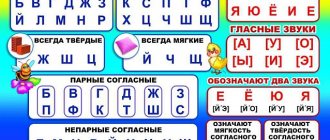Voiced and unvoiced sounds
Consonant sounds are also classified into voiced and voiceless. The former consist of voice and noise, while the latter consist only of noise.
The voiced category includes: [B], [G], [D], [F], [Z], [V], [Y], [L], [M], [N], [R].
The deaf group includes: [К], [П], [Х], [Ц], [Ч], [С], [Т], [Ф], [Ш], [Ш].
Most consonants can form pairs based on deafness and hardness:
[B]—[P] [V]—[F] [D]—[K] [D]—[T] [G]—[S] [W]—[W]
Voiceless and voiced consonants are easy to remember using two sentences:
- “The Lion and the Toad Have Many Friends” (Voiced)
- “Styopka, do you want a cheek? - Ugh!" (Deaf).
You can memorize them or print them out on a separate card.
Table of hard and soft sounds
All rules are collected in one table. At first glance, it may seem like gobbledygook to a child, but after accessible explanations and careful study, the new material will no longer seem so complicated.
Print and hang this picture in a visible place so that your child can learn these rules at any convenient time.
Always hard and soft sounds
Now it’s time to find out the names of those very rebels who did not want to surrender to the enemy without a fight. The sounds Ch, Shch and Y are always soft, but C, Zh, Sh can only be hard. These are six consonant sounds that are still waging their quiet war and do not want to submit to the power of vowels. It doesn't matter who they happen to be next door to. The steadfastness of these sounds is admirable.
How to teach a child to distinguish sounds
Children perceive information best if it is presented in a playful way. Together with your child, come up with an interesting story that will help explain the complex relationship between hard and soft consonant sounds.
Once upon a time, hard and soft sounds lived together. There was no enmity or quarrel between them, until one day an ambitious group of vowels, which included E, Yo, Ya, Yu and I, wanted to gain power over everyone. A war began that lasted for many years. A, O, U, E and S remained neutral and preferred to stay away, because they could not take anyone’s side. The war dragged on, so the vowels decided to use cunning. They turned for help to a soft sign, which does not have its own sound at all, but loves to pit others against each other.
This harmful letter told the vowels about the place where the consonants were hidden, and in return demanded a number of privileges after the successful completion of the military campaign. As a result, the consonants were surrounded. A group of militant vowels gave them an ultimatum and those who agreed had to accept their terms. The war was lost and the winners celebrated their success with pomp.
A small group of vowels received undivided power. Now they determine whether the consonant sound will be soft or hard. The soft sign received exactly the same rights. Now he, too, can push around the vanquished. Although among those who agreed there were also those who did not want to put up with the circumstances. All the hissers, along with a couple of comrades-in-arms, did not raise the white flag and went to partisans in the forests. The compliant consonants now strictly obey the laws of the vowels, and a few rebels continue to carry out sabotage activities, although without much results.
This simple story clearly demonstrates the peculiarities of the relationship between vowels and consonants. The names of the rebels that we will mention later should be immediately blacklisted. They are still wanted by the vowels for their disobedience. A "Wanted" sign can be placed on the refrigerator or near your little student's desk.
This hint should be constantly in front of the child’s eyes. The remaining consonants, which submitted to the victors, are now forced to become either soft or hard depending on their neighbors. If they are followed by the vowels E, E, I, Yu, I or b, then they become soft because they lose their will in front of the winners. If another vowel (A, O, U, E or Y) or consonant lands on their tail, then they become firm, as they feel support.
Hard and soft consonants
How to teach a child to distinguish soft sounds from hard ones? We must start with the fact that softness and hardness are characteristics only for consonant sounds. The vowels here are in the chorus. Although hardness and softness are not typical for them, it is their close proximity in some words that can affect these properties of consonant sounds. The main difference between soft and hard sounds is the peculiarities of their pronunciation.
If a person pronounces soft consonant sounds, then the middle of his tongue rises to the palate and blocks the passage through which the air moves, and the tip moves slightly forward towards the teeth. This is additional articulation. The process itself is called palatalization.
Kids don’t need to know such complexities, but parents may find this term useful to broaden their horizons. This does not happen when pronouncing solid sounds.
To understand the difference yourself, it is enough to say a test word in which the same sound acts as a hard and soft sound.
Let's take "break" as an example. Pronunciation of the first consonant sound [p'] makes the tongue dance in the mouth and rise to the sky, but for the second consonant sound [p] these somersaults are not needed.
It’s easy for parents to understand the difference, but how can you explain it to a child? We suggest using your imagination and using interesting stories, cheat sheets and simple games that will help kids remember hard and soft consonant sounds.
Recording sounds
In transcription, the softness of a consonant sound is indicated by adding the symbol ' to its notation. This is an apostrophe that appears in some loanwords.
For example, to indicate the softness of the sound P in transcription, you need to write [p']. The hardness of the sound is not indicated.
There's nothing complicated about it. Offer your child a simple task. He needs to write out from a group of words only those that contain soft consonants, and then transcribe them with an apostrophe. Just a few of these exercises, and he will quickly remember how softness is indicated.
Phonetic analysis of the word
Why do you need phonetic analysis of a word?
Phonetic analysis gives the sound characteristics of a word.
With its help, you can break down a word into letters and sounds. Match the number of letters and sounds. And find out the discrepancies between letters and sounds, if any.
What is the order of phonetic parsing?
Phonetic analysis is carried out in the following sequence.
- Indicate the number of syllables and indicate stress.
- Count the number of sounds and letters in a word.
- Describe vowel sounds: stressed/unstressed.
- Describe consonant sounds: voiced/voiceless, hard/soft.
Vowel sounds and letters
There are six vowel sounds in Russian:
[a], [o], [y], [e], [i], [s].
In writing, sounds are represented by ten vowel letters:
a, i, e, e, o, u, s, e, yu, i.
For example:
- [a] – a (March) and I (mint)
- [and] – and (cinema)
- [s] – s (mouse)
- [o] – o (walrus) and e (aunt)
- [e] – e (echo) and e (accuracy)
- [y] – y (hoopoe) and yu (humor).
The ten vowel letters are easy to remember in pairs.
What is special about e, e, yu, i?
The four iotized letters e, e, yu, i stand out among others by two abilities:
- influence the preceding consonant, making it soft: to love - [l'u]beat.
- breaks down into two sounds:
| I | [y'a] |
| E | [y'e] |
| Yo | [y'o] |
| YU | [y'u] |
In transcription (in the designation of sounds) the letters e, e, yu, i are not used. They were excluded from the soundtrack.
In what cases do iotated vowels split into two sounds?
The letters e, e, yu, i represent two sounds:
- if the words appear at the beginning: amber - [y'i] amber,
- after a vowel: lightning – lightning[y'a],
- after ь and ъ signs: shrink - shrink.
Why can vowel sounds be strong and weak?
The power of vowel sounds is given by a special place in a word - stress. Under stress, the sound is pronounced clearly: wolf, park, forest, table.
Weakens the vowel - unstressed position. Thus, vowels lose their strength and change in the words five - p[i]terka, diaper - p[i]lenka, since the sound [i] is unstressed.
The vowel sound is part of the structure of the syllable, for this reason there are as many syllables in a word as there are vowel sounds.







